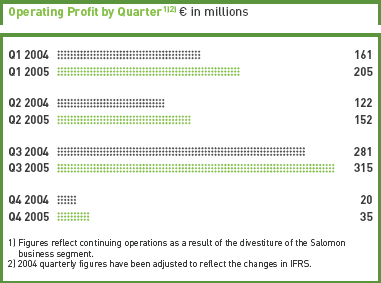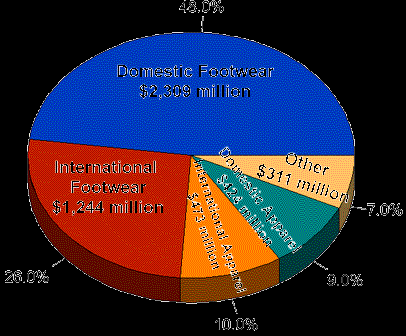The two major sportswear and sports footwear industries in Germany are Adidas and Puma. These two were owned by brothers Adolf Dassler and Rudolf Dassler where after the relationship between the brothers deteriorated they decided to part ways in business, Adolf went on to open Adidas while Rudolf established Puma. These two companies compete with each other internationally and are the most vibrant current trend setters in the industry in Germany (Smit, 2007 145: James, 2000 256)

Adidas and Nike market share
Major economic trends and forecasts and what impact on the industry in the country
Globalization, as in any other industry the world over, has definitely impacted the sports footwear industry in Germany. Leading companies in the production of sports footwear have been forced to relocate internationally to take advantage of key opportunities internationally.
Globalization helps a firm to spread political and economic risk whereby, joint ventures have become widespread as a way of meeting the need to tap the international market, technological knowledge, design and skills (Smit 2009 98).
Some of the major competitors of Adidas and Puma such as Nike relocated to countries in Asia such as Thailand and China exclusively because of low labor cost in these countries comparative to those of firm’s country of origin.
This has translated to low operating costs for these firms hence they are able to lower the price of their products comparative to that of its competitors which in turn has given such firms an extra edge over their competitors in terms of pricing. This means that such companies will chip away at some of Germanys’ leading producers of sportswear market share.
Entry barriers into the sportswear market are relatively few (Daniels et al 2002 38). This scenario has to led many investors trying their luck in the lucrative sports footwear industry.
As a result, the market has become fragmented due to a lot of competitors entering the industry and as result, the market share of leading producers of sports foot wears are gradually loosing their market to their ever increasing competitors. In turn this has prompted leaders in the industry of sports foot wear to shift their focus to acquisition of additional brands merging with other firms in an effort of consolidating their position as leaders of this lucrative industry (Simon & Dave 2006 26).

Adidas operating profits
Globalization has contributed to the increase in the pace of technological advancement. The market leaders in the sports footwear industry in Germany are feeling the heat forcing them to act faster if they are to remain competitive in the days to come. To compete effectively, Adidas and Puma are constantly pushing for technological advancement, increase in productivity and efficiency in product development together with channel distribution (Esterl 2000 56).
In addition, they are feeling the pressure of improving the performance of their footwear as the competition constantly keeps forcing them to do. A good example of this is Adidas adjusting the cushioning around their running shoe depending on where it is needed most. This was read as a retaliatory move on the part of Adidas to Nike’s embedding of a micro chip into their shoe showing the statistics of what distance the wearer of the shoe covered and at what speed (Epstein 2003 96).
In the wake of the recent economic melt down, demand for products of both Adidas and Puma leveled off and as the economic crisis worsened, it went on to dip to unprecedented levels.
This slump demand of sports footwear was occasioned by the reduction in the amount of disposable income among the consumers since there was no single sector of the German economy that was not affected by the economic crisis. The cost of energy skyrocketed, food prices went through the roof, the rate of unemployment dipped, house values declined, the stock market tumbled among other things leaving the consumers with less discretionary income (Jones,1999 87).
The consumer confidence index read 24, as at 2008, the lowest point in the history of the index. This was largely attributed to consumers’ preference of saving as opposed to spending due to the gloomy outlook of the future at that time. The decrease in demand for sports footwear resulted in reduction of revenue for the industry leaders as well as their competitors.
The footwear producers are continuously faced with the challenge of high environmental demands. In the process of manufacturing their products, their factories emit fumes which are harmful to the environment and inhabitants living around the factory. The way these factories dispose off waste water is also a cause for concern to the authorities responsible of monitoring the environment as the green initiative is catching on the world over.
Consumers want to be associated with firms that have aligned their production processes to this noble initiative in an effort of reducing the rate at which the environment around them is dissipating. So in order for both Adidas and Puma to retain their customer base along with aiding in the noble course of conserving the environment, they should develop and implement codes of practice for sustainable production and protection of the environment.
Since they are the market leaders, they should be on the forefront in mobilizing the entire sports footwear industry in a collective effort to reduce the emission of green house gases into the atmosphere on a global scale. This will go a long way in reducing the carbon footprint and aid in the conservation of the environment.
Germany is the 5th largest energy consumer in the world and the leading energy consumer in Europe. Since Germany is a highly industrialized nation, running of these industries using non-eco friendly energy would have led to pollution of the atmosphere on a grand scale thus the German government put in place policies which promoted energy conservation and development of renewable sources of energy such as solar, wind and biomass (Books LLC 2010 78)
The German government has been very instrumental in the creation of environment that the sports footwear industry could thrive in. This is so due to the policies that the German government has put in place in an effort of protecting its industries that are exposed to international competition therefore German government’s approach to the creation of a vibrant and lucrative industrial economy is straight forward.
The German government opted to produce a highly educated workforce, this workforce went ahead and produced merchandise that was technologically advanced which were then exported abroad at high prices. This approach may on the surface appear to be very simplistic but in reality it was highly effective. It is not for nothing that Germany is the world’s second largest exporter after China despite her being dwarfed by her competitors such as China and the United States in terms of population.
The secret to the success of Germany’s industrial economy lies in the policies implemented by the German government which are; heavily investing in its citizens and in research and development (Epstein,2003 76)
The German government has a policy in place that regulates the market labor. Since Germany has a highly skilled workforce, their remunerations are also high. Considering the fact that most of Germany’s competitors such as China have the advantage of cheap labor, one is tempted to question the soundness of such a policy.
This policy is not at all flawed, it is a fact that it serves as a constraint to domestic companies, such as Adidas and Puma, from racking their brains in search of strategies that will make their prices more competitive based on lower cost of wages.
Since the option of lower cost wages is not available to them, these companies will shift their attention to developing merchandise that are way superior to their competitors’ in terms of technology and export them at equally higher prices. Most of German products are high end stuff that is bought by rich clients. Germany’s competitors find it difficult to match their technological prowess. This leaves Germany with the moneyed segment of the market all to itself (Haig 2006 29)

Nikes sales domestic and foreign markets 2008
In addition, the German state intervened and supported various industries by installing complex infrastructure. This intervention has aided the various firms in responding adequately to the pressure that arises out of international competition.
The government has also equipped its citizenry with skills, financial and technological resources to pursue quality competitive strategy as opposed to price competitive strategies (Books LLC 2010 64)
References
Books LLC., 2010. Athletic Shoe Brands: Nike, Inc. Melbourne, Australia: General Books LLC.
Books LLC., 2010. Shoe Companies of the United States: Nike, Inc. Melbourne, Australia: General Books LLC.
Daniels, J., et al., 2002. Globalization and business. Upper Saddle River, NJ: Prentice Hall.
Epstein, A., 2003. Sports Law. Clifton Park, NY: Thomson Press.
Esterl, M., 2000. Review of “Sneaker Wars: The Enemy Brothers Who Founded Adidas and PUMA and the Family Feud That Forever Changed the Business of Sport. St. Paul, MN: West Publishing Co
Haig, M., 2006. Brand Royalty: How the World’s Top 100 Brands Thrive & Survive. London, UK: Kogan Page Publishers.
James, K.. The Town that Sibling Rivalry Built, and Divided. New York, NY: John Willey.
Jones, M., 1999. Sports Law. Upper Saddle River, NJ: Prentice-Hall
Simon C., & Dave A., 2006. International cases in the business of sport. New York, NY: Butterworth-Heinemann.
Smit, B., 2007. Pitch Invasion, Adidas, Puma and the making of modern sport. Camberwell VIC 3124, Australia: Penguin.
Smit, B., 2009. Sneaker Wars. New York, NY: Harper Perennial.